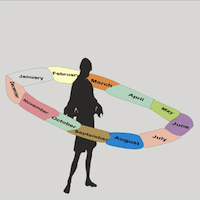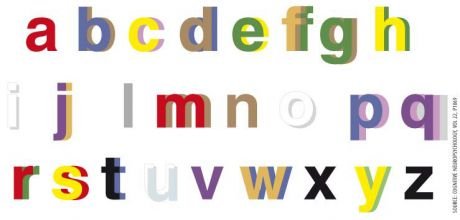What is synesthesia?
Wandering through my landscape by synesthete artist Carol Steen. Read more about Carol’s work in Carol Steen’s Evolving Synesthetic Worldscape by Greta Berman.
Some people with synesthesia can experience colour sensations through non-visual senses like taste or hearing. Others can see black letters or numbers printed on white paper or screens as coloured. They have an intermingling of the senses, which affects how they interpret sensory information.
About 4% of the population has some type of synesthesia, which is a neurological phenomenon where the activation of one sense induces a response in a different sense, like hearing or tasting colours. There are many types and variations of synesthesia, and colour is a common element of the synesthetic experience. The exact mechanisms which cause synesthesia are still not fully understood. Synesthetes have enhanced neurological connectivity in their brains compared to non-synesthetes. Likely there are multiple mechanisms, which produce variations in the ways synesthesia is experienced by different synesthetes. True synesthetic experiences are automatic and involuntary, and are perceptual, not metaphorical.
Sound-colour associations of synesthete Tracey Roberts
Spatial sequence synesthesia (Image source: Synesthesia test).
Prototypical synesthetic alphabet (from the University of Sussex Synesthesia Research group)
In many types of synesthesia, the perception of colours can be induced by other senses: the musical note E-flat is a “velvety hot pink”, or the sound of the name Julie is a “pale, metallic green”, or chocolate smells “pink and stripy”. Each person with synesthesia will have their own set of associations, which (most likely) will last throughout their lives.
Besides the traditional senses, concepts and ideas can also invoke sensory responses. For example, the days of the week or months of the year may each be a different colour, and follow a sequence through space around your body. In another common type of synesthesia, either written numbers and letters, or the ideas of numbers and letters can induce colour sensations. The letter A might be a “pale, shimmery pink” to one synesthete but a “dark, melodramatic orange” to another. Letters or numbers may also have genders and personalities: 13 is “friendly and nice, talkative, a girl, and probably my favourite colour, shiny and soft like jelly”. Notice that the synesthetic associations are not always simple and one-dimensional, like “the letter A is red”. Descriptions of synesthetic associations are frequently complex, and include all colour attributes, along with textures, and other visual and emotional qualities.
The interconnectivity of the senses is profoundly intriguing for non-synesthetes. Some glimpses into synthesthetic experiences have become part of our culture and language, as in, for example, tasting a sharp cheese or seeing a loud tie. Metaphorical connections between sounds and colours are important sources of inspiration among artists and musicians. As these associations are metaphorical, they are not considered true synesthesia, but nonetheless play an important role in art and culture.
Animator Samantha Moore captured synesthetic experiences in her video An Eyeful of Sound.
FIND OUT MORE:
Research on this highly engaging topic is ongoing, and the state of knowledge is constantly evolving. Below are some links on synesthesia.
Synesthesia research group at University of Sussex: https://www.sussex.ac.uk/synaesthesia/ (includes a questionairre if you think you have synesthesia and an FAQ about synesthesia)
Good general resource on synesthesia and for synesthetes, by Sean Day: http://www.daysyn.com/
TedEd video: What Colour is Tuesday? Exploring Synesthesia by Richard Cytowic
Synesthesia information and tool kits for teachers. Includes information on how teachers can support students with synesthesia in the classroom.
Comprehensive overview of synesthesia types: The Synesthesia Tree






